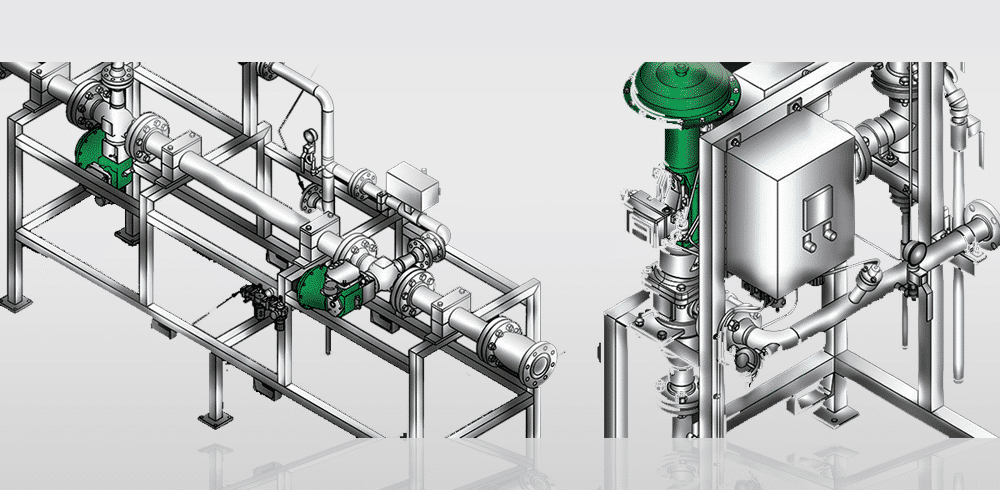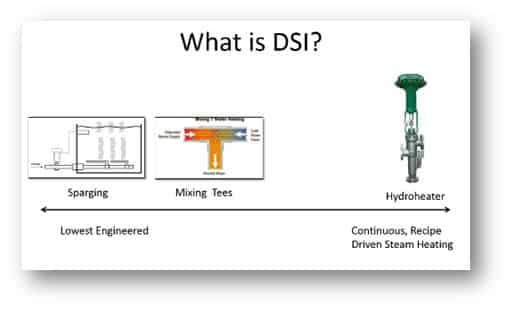



Hydroheaters/Jetcookers control both steam flow and mixing turbulence by employing a modulating stem plug and nozzle assembly inside the heater. The precise mixing of metered amounts of high-velocity steam directly with a liquid or slurry provides instantaneous transfer of heat from steam to the liquid.
To accomplish this, a precisely engineered, variable-area steam nozzle meters the flow at the point of injection and contact with the fluid. The large pressure drop from full steam pressure to the process fluid pressure ensures high-velocity choked steam flow and instantaneous mixing of the two streams. When steam flow is choked, its velocity at the nozzle exit is constant regardless of the total mass flow injected. The internally modulated Hydro Thermal heaters control the amount of injection area (cross-sectional area of the nozzle opening) to precisely regulate the heat load. The constant steam velocity results in consistent and stable operation across the full range of operation.
Hydro-Thermal’s patented direct steam injection heaters are ideal for heating liquids and slurries over a wide range of viscosities and solid contents to precise temperatures. A Hydroheater’s internal modulation assures exacting steam control, rapid temperature management, and produces predictable results. Each Hydro-Thermal heater has internal trim custom designed to each customer’s specific needs and requirements.
Hydroheaters/Jetcookers commonly outperform other forms of direct steam injection as well as indirect heating methods such as heat exchangers. Below is an overview of indirect vs. direct heating and how Hydro-Thermal’s patented technology outperforms the status quo.

Externally or Internally modulated direct steam injection refers to how the mass flow of steam injected into the process fluid is controlled.
External modulation uses a steam control valve on the supply line to vary the pressure of the steam at the point of injection: Varying the pressure changes the steam density and velocity through the nozzle to control the amount of heating. Regulating steam pressure to control heating can result in unstable operation, hammering and vibration, when high or low steam flowrates are are required. At low steam flow, ie. trim heating, the differential between steam pressure and process can be very small and a slight fluctuation in either pressure can cause an upset. Alternatively, at high steam flow requirements, ie. max heating at startup, the orifice or nozzle size will allow more steam than can be condensed and steam hammer occurs.
Internally modulated DSI controls the injection area rather than steam velocity and density to regulate the amount of heating. An internally modulated heater operates at higher steam velocities compared to external modulation. This higher velocity produces improved, often rapid mixing and nearly instantaneous condensation of the steam into the process fluid.
There are two basic types of exchangers used to transfer heat between process fluids — direct and indirect. Indirect heating is most commonly seen in the form of plate & frame or shell & tube heat exchangers. Any process that does not allow direct mixing of steam and fluid is indirect heating. Heat exchangers transfer heat through a membrane or solid wall. This results in only ~ 83% of the heat energy transferred to the process fluid while the remaining energy is discharged in the condensate formed from the steam.
Direct heating, on the other hand, uses 100% of the steam’s heat energy by adding steam directly to the process fluid. The benefits of using direct contact heating vs. indirect include:
Additional benefits:

Hydro-Thermal’s heaters utilize direct steam injection. This general term refers to any type of fluid heating that utilizes steam being directly mixed with water or process fluid. There are many forms of direct steam injection including: spargers, eductor pumps, externally modulated heaters, and internally modulated heaters. Each method varies in its levels of complexity, with sparging being the most simple and internally modulated having the greatest level of technology and control.
Sparging
Sparging is the oldest, simplest and least complicated technique for mixing steam with liquid or slurry to affect heating. It is basically injecting steam directly into a fluid filled tank. Though considered simple and inexpensive, sparging is very inefficient and the operation invariably results in:
Mixing Ts
Mixing Ts combine separate streams of steam and cold water to produce heated water. Because accurate temperature control is difficult to maintain with this method, mixing Ts are not the best choice for process fluids. When used for water, mixing tees are prone to scaling, fouling and excessive hammer. Their operation often requires the steam and water pressure to be very close to each other for balanced mixing. When either steam or water pressure fluctuates slightly, the higher pressure line can overcome the other and backfill the piping. This can result in live steam discharging the system. The drawback of Mixing Ts are:
Sparge Tube
The externally modulating sparger tube (MST) heater consists of a spring controlled, variable-injection sparger tube inside a cast process flow body. In response to a temperature sensor, the external flow control valve modulates the steam to a spring-loaded piston. MST heaters work reasonably well on clear liquids and some low solids solutions but are subject to severe clogging and steam hammer if frequent maintenance is not performed. In typical water heating applications, these devices typically require monthly tear down and acid bath cleaning. Since the steam flow is dependent upon a spring loaded valve, accurate temperature control is difficult once the spring begins to wear. Additionally, if low (trim heating) or high steam flow is required, the spring mechanism can have difficulty with accurate or stable control. Spring failure is a common issue with this type of heater. Additional drawbacks of sparge tubes are:
Internal Modulation
Hydro-Thermal’s technology, which utilizes internal modulation, is the most advanced form of direct steam injection. It has many benefits over other direct heating methods including: